[vc_row][vc_column][vc_column_text]
Educational opportunities in Kansas can be amongst the best in the nation if we focus on students, learn from the example of states like Florida, and move past the partial truths and talking points of “supporting public schools.” Since much of what has been written about K-12 education is either misleading or simply not true, Kansas Policy Institute is providing the following 5 things you need to know. The facts we cite are all provided by the Kansas Department of Education, the U.S. Department of Education, the Bureau of Labor Statistics, ACT.org, and a review of Kansas laws.
#1 – Low achievement levels on the state assessment
State assessment tests administered by the Kansas Dept. of Education (KSDE) reflect much lower achievement than parents have been led to believe. In fact, many districts have more 10th-graders below grade level in math than are on track for college and career; statewide, 47% are below grade level, a third are at grade level but need remedial training, and only 20% are on track for college and career.
Even in Johnson County, 35% are below grade level and only 31% are on track for college and career. Achievement levels now are generally worse than in 2015, the first year of the current state assessment model.
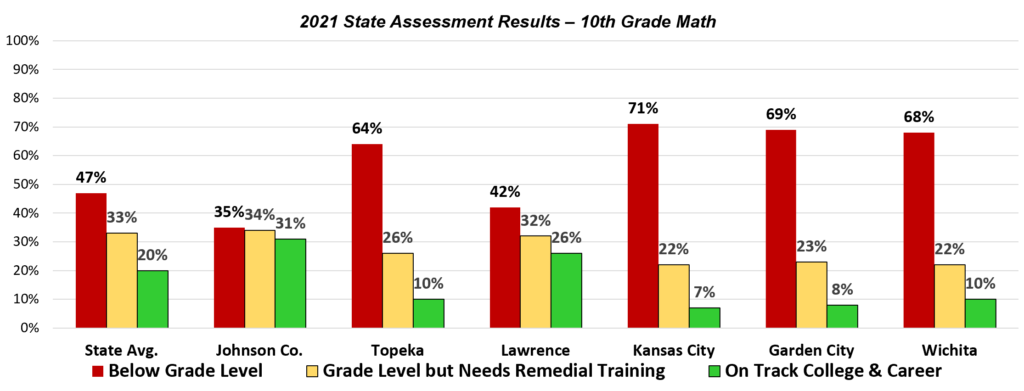
#2 – College readiness is low and declining
The average 2021 ACT score in Kansas declined for the fifrth consecutive year, to 19.9, and the decline in college-readiness to 21% marked the sixth consecutive drop. Kansas is now below the national average, which fell from 20.6 to 20.3.
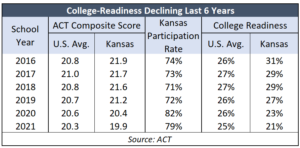 Only 21% of Kansas students did well enough to be considered college-ready in English, Reading, Math, and Science on the 2021 ACT. That’s down from 27% in 2019 and again below the national average, which is 25%.
Only 21% of Kansas students did well enough to be considered college-ready in English, Reading, Math, and Science on the 2021 ACT. That’s down from 27% in 2019 and again below the national average, which is 25%.
State average scores are skewed by two major factors – demographic differences among the states and participation rates (the percentage of students taking the ACT in each state).
Participation rates affect average state scores because in states where the ACT is not mandatory, only students planning to attend college are likely to take the test and that will artificially increase average state scores over states where the ACT is mandatory for all students. The
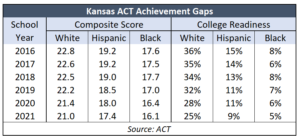 Kansas Legislature recently approved paying for all students to take the ACT and the state’s participation rate jumped from 72% in 2019 to 82% in 2020, but then dropped to 79% in 2021. The higher participation rate wiped out some of the state’s artificial advantage and partially contributed to the lower score.
Kansas Legislature recently approved paying for all students to take the ACT and the state’s participation rate jumped from 72% in 2019 to 82% in 2020, but then dropped to 79% in 2021. The higher participation rate wiped out some of the state’s artificial advantage and partially contributed to the lower score.
Large achievement gaps between white students and students of color, and between low-income students and everyone else, also skew state average scores. States with higher portions of minorities and low-income kids will appear to have lower average scores because of achievement differences.
ACT doesn’t publish income-based demographics but the achievement gaps in Kansas between White, Hispanic, and Black students are significant and persistent. Only 5% of Black students are college-ready compared to 9% for Hispanic students and 25% for White students.
#3 – Kansas is not in the Top Ten
The Kansas Association of School Boards routinely declares Kansas to be among the ten best states for student achievement, but that has never been true. In fact, Kansas hasn’t had a single Top Ten ranking on any of the demographic measurements on the National Assessment of Educational Progress (NAEP) since first participating in 1998.
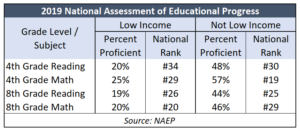 The state’s best ranking in 2019 is #19 (4th-grade students who are not low-income in math). Five rankings are in the 20s and two are in the 30s, with the lowest ranking for 4th-grade low-income students in reading, at #34.
The state’s best ranking in 2019 is #19 (4th-grade students who are not low-income in math). Five rankings are in the 20s and two are in the 30s, with the lowest ranking for 4th-grade low-income students in reading, at #34.
By the way, NAEP is considered the ‘gold standard’ for comparing performance across states by education researchers.
#4 – Spending money does not cause achievement to improve
Contrary to claims by school officials, Supreme Court judges, and others, spending more money does not cause student achievement to improve.
Per-pupil spending has grown much faster than inflation over the years, but achievement on the ACT and NAEP declined a bit. If per-pupil spending had been increased for inflation, it would have gone from about $7,000 in 1998 to less than $11,000 this year, but KSDE estimates spending will exceed $16,000.
Meanwhile, reading proficiency for 8th-graders in Kansas dropped from 36% to 32% in 2019, the most recent NAEP results. Reading proficiency for 4th-graders remained flat at 32%.
Nineteen states had the same or better NAEP 8-score composite in 2019 than Kansas and spent less per student (4th-grade and 8th-grade Reading and Math for low-income kids and students who are not low-income compared to 2018 spending per U.S. Census, adjusted for cost of living).
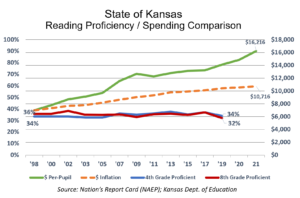
#5 – Florida achievement skyrockets while Kansas is stagnant
In 2003, Kansas led Florida on six of the eight primary NAEP measurements; there was one tie and Florida was ahead in measurement. But in 2019, it was just the opposite; Florida won six measurements, there was one tie, and Kansas was ahead on one.
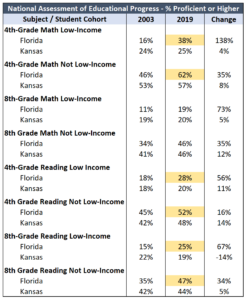 It wasn’t money that made the difference; the most recent 2018 data shows Florida spent about $4,000 less per student than the national average, and about $3,000 less per student than Kansas.
It wasn’t money that made the difference; the most recent 2018 data shows Florida spent about $4,000 less per student than the national average, and about $3,000 less per student than Kansas.
As explained in “Giving Kids a Fighting Chance,” Florida educators, parents, and legislators attribute their gains to a combination of choice, transparency, and accountability.
Florida has the most robust school choice offerings in the nation, including charter schools, education savings accounts, and tax credit scholarships; Kansas has one small tax credit scholarship that the education lobby wants to be eliminated.
Florida adopted an “A through F Grading System” so parents can see a letter grade on every public school and track its progress; the Kansas education lobby, as shown earlier, distorts achievement to make parents think it is much higher.
Florida has accountability measures like their 3rd-Grade Reading Initiative. The 3rd grade is critical because, in the first three years, students are learning to read; thereafter, they are reading to learn. Florida law specifies reading requirements for third-grade students and promotion to fourth grade.
In Kansas, local school boards and administrators are not held accountable for improving student achievement or for spending money in students’ best interests. State assessment results show many students are persistently below grade level and state audits have shown money isn’t being spent as intended by the Legislature, yet there are no consequences imposed.
The lack of accountability creates a perverse disincentive to help students improve. School lobbyists and lawyers say that having so many students below grade level somehow ‘proves’ that schools don’t get enough funding; the court system agrees and orders billions more be given to schools, but achievement doesn’t change. A few years later, schools go back to court with the same claim and ask for even more money. Improving student achievement would undercut their claims of being underfunded.
Two accountability measures being considered by the Legislature would address these problems. Senate Bill 362 requires school districts to publish their building needs assessments and identify barriers to improved achievement, the related budgetary changes they will make, and declare the number of years it will take to get all students to grade level under their plan.
House Bill 2550 creates education savings accounts for students who are financially or academically determined to be at-risk by school districts, thereby creating an incentive for districts to at least get students to grade level.
[/vc_column_text][/vc_column][/vc_row]





